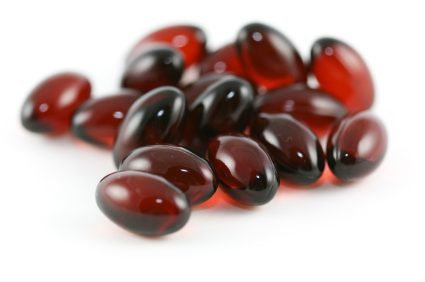- Home
- Our story
- Nutrition Quickies
- Products
- Ingredients
- Articles
- Success Stories
- Contact Us
- Timeless Radiance
- JayLab Pro Prosta-7
- BloodFlow Guardian
- VG-6
- Ultimate Sleep Solution
- Fermented Turmeric
- Collagen Complex
- LeptiSense
- Ultra-Cleanse Detox
- Krill oil
- Probiotics
- Advanced Joint Support
- Gluco Guardian
- Multi-vitamin (Active Core Complex)
- Renewal for men (T20)
- Protein powder
- Combo-packs
- Login
This unique marine antioxidant can help prevent diabetes and fight fat gain.
Can Astaxanthin Help Prevent Weight Gain?
By Cassandra Forsythe-Pribanic, PhD, RD, CSCS
Astaxanthin - although it sounds like one of those molecules in your chemistry class that haunted you while studying for final exams, it’s actually a very powerful antioxidant with several health-promoting properties.
One health benefit in particular is its ability to protect your body against diabetes. It does this by fighting oxidative stress and preventing insulin resistance – two of the underlying causes of this common disease.
Oxidative De-Stressing
Oxidative stress refers to oxidative damage in a cell, tissue or organ, caused by Reactive Oxygen Species (ROS), which are unstable free radical molecules containing oxygen that steal electrons from other molecules. This then makes the newly damaged molecule another free radical.
ROS are often dangerous because they’re linked to many negative effects in the body such as increased inflammation, permanent cell damage and even cell death.
Antioxidants come to our rescue against ROS because they stabilize the free radical molecule and prevent it from causing any destruction.
Diabetes and Oxidative Stress
Diabetes is strongly linked to oxidative stress as either a consequence of increased ROS production, reduced antioxidant status, or both.
Oxidative stress in diabetes is brought on by consistent hyperglycemia (high blood sugar levels) from a very high carbohydrate diet, reduced cell carbohydrate uptake, and/or low insulin output from the pancreas.
People who have pre-diabetes, or full diabetes, are wise to follow a diet much lower in carbohydrate than they usually eat, and increasing their physical activity. These changes will help reduce blood sugar concentrations and in turn, reduce levels of oxidative stress.
However, these changes take time and a lot of discipline (especially if you’re a carbohydrate addict). Thankfully there are ways to reduce oxidative stress until these beneficial changes have become new, good habits.
Astaxanthin Reduces ROS and Improves Immunity
Japanese researchers found that astaxanthin could lessen oxidative stress in pancreatic beta cells (the cells in your body that produce insulin) caused by chronic high blood sugar levels. In turn, this improves the body’s ability to manage blood glucose levels by allowing the pancreatic cells to make the right amount of insulin when needed.
Astaxanthin was found to improve pancreatic beta cell function and protect these cells from glucose toxicity which leads to progressive cell breakdown and death (Uchiyama K et al, 2007). It did this by battling the damaging ROS molecules through increased antioxidant levels (via astaxanthin).
Another group of researchers also found that astaxanthin treatment improved immunoprotective properties of lymphocytes (special white blood cells that are part of a normal immune response) (Otton R, 2010).
In diabetes there is a strong correlation between oxidative stress and poor immune function. Astaxanthin helped the lymphocytes do their job more effectively and fight off foreign objects such as bacteria, viruses, and pathogen-infected cells so that persons with diabetes would not be sick as often.
Prevention of Fat Gain
Recently, a group of researchers from India (Bhuvaneswari S et al, 2010) showed that increased blood glucose and excessive insulin levels brought on by a high processed fat and high sugar diet could be deterred with astaxanthin treatment.
What this means is that astaxanthin prevents insulin resistance and improves glucose handling. As a result of this, a long term high processed fat and sugar diet was not able to cause a significant increase in body fat, fatty liver, or suppress immunity.
Although this is good news for those of us that may not always eat well every day, it definitely does not condone a constant diet rich in French fries, doughnuts, cookies, Pop Tarts or artificial Cheese Twists.
Where Do You Get Astaxanthin?
This brightly red-colored antioxidant is found in the lipid compartments of several species of microalgae that feed the millions of crustaceans and fish found in our oceans. Astaxanthin is one of the major reasons salmon is tinted pink and krill are deep red. The krill eat these microalgae first and accumulate them in a greater concentration than the salmon who eat fish who eat the krill.
Your best source of astaxanthin is therefore high healthy fat, red-colored marine animals such as krill and salmon. Omega Icon is one of the most concentrated sources of astaxanthan.

Stop Diabetes Now
According to our most recent statistics from 2007, 57 million people have pre-diabetes, and 23.6 million children and adults have full-blown diabetes; don’t let yourself become the next statistic.
In order help protect your body against the development of diabetes, which is a disease that affects more people in the US than need be, make sure you’re including astaxanthin from Krill Oil like Omega Icon in your diet and keeping sugar and processed fat low.
References
Uchiyama, K., Naito, Y., Hasegawa, G., Nakamura, N. et al., Astaxanthin protects b-cells against glucose toxicity in diabetic db/db mice. Redox Rep. 2002, 7, 290–293.
Otton, R., Marin, D. P., Bolin, A. P., Santos, R. D. et al., Astaxanthin ameliorates the redox imbalance in lymphocytes of experimental diabetic rats. Chem. Biol. Interact. 2010, 186, 306–315.
Bhuvaneswari, S., Arunkumar, E., Viswanathan, P., Anuradha, C. V., Astaxanthin restricts weight gain, promotes insulin sensitivity and curtails fatty liver disease in mice fed an obesity-promoting diet. Process Biochem. 2010, 45, 1406–1414.
